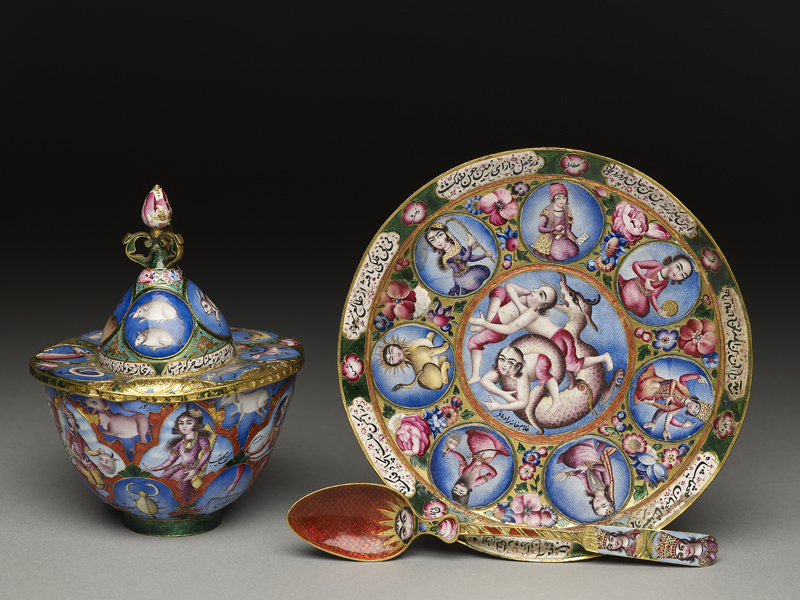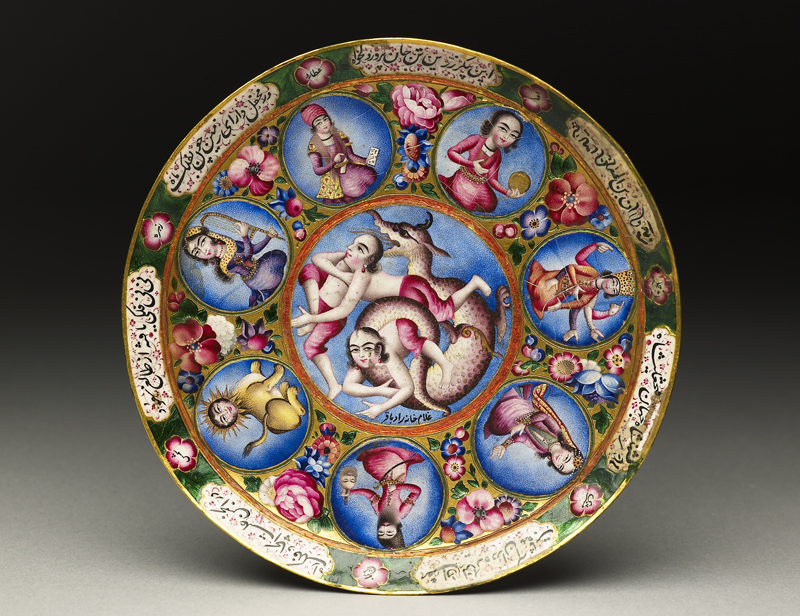Walking in the Islamic Middle East Gallery at the Ashmolean Museum, visitors may encounter a set of objects of impressive finesse and intricacy (fig. 1). Comprising a lidded cup, saucer and spoon, this small gold enamelled coffee set is not only a triumph of skill and inventiveness, but also a unique lens through which a whole cultural and metaphysical context can be observed.

Fig.1 Set with Astrological Decoration, Iran, early 19th century, gold, enamelled. Accepted by HM Government in lieu of Inheritance Tax on the Estate of Basil Robinson and allocated to the Ashmolean Museum, 2009 (EA2009.2-4) © Ashmolean Museum, University of Oxford
Used for imperial regalia and diplomatic gifts since the Safavid period (1501-1736), the technique of gold enamelling became quite popular under the Qajar dynasty (1785-1925), the time when this and other comparable surviving enamels were produced. Luckily, in this case an elaborate poem distributed in elongated cartouches reveals the identity of its recipient, Fath ‘Ali Shah Qajar (r. 1797-1834), an ambitious leader and formidable patron of the arts.
In the verses bordering the saucer Fath ‘Ali Shah is compared to the Sun, acknowledged as ‘the cause of creation and the way of heaven’ and celebrated as a source of cosmic order thanks to which ‘the seven planet stars have attained their stability’. Immediately below, the decorative programme responds to the verses with personifications of the planets in a sequence of roundels: at 1 o’clock is the Moon, with its disk; at 3 o’clock Saturn, resembling a Hindu deity with multiple arms and attributes; at 5 o’clock Jupiter, unusually represented as a young kneeling woman; at 6 o’clock Mars, holding warlike attributes; at 8 o’clock the Sun; at 10 o’clock Venus, the harp-player; and, finally, at 11 o’clock the learned Mercury.

Fig.2 Personifications of the six planets and the pseudo-planet Jawzahr, ‘the dragon’ (EA2009.3) © Ashmolean Museum, University of Oxford
The astral symbolism continues on the cup and its lid in both word and image (fig. 3). The poetry on the cup is especially ingenious in its use of puns and metaphors. It compares the reflection of the cup’s holder to a glowing Moon, a frequent paragon of beauty in Persian poetry, and declares the heavens and the zodiac ‘in the grasp of the Sun’, as by holding the cup the august ruler would symbolically have the universe in his hands. To fulfil this vision, the signs of the Western zodiac have been densely stacked on the outer surface of the vessel, alternated with personifications of the six main constellations: Cassiopeia, Perseus, Arcturus, Andromeda, Sirius and Serpens. To emphasize Fath ‘Ali Shah’s universal authority further, the lid carries another set of zodiacal signs drawn from the East Asian tradition and probably filtered to Iran through its past Mongol rulers and extensive contacts with China.
One image remains enigmatic. This is the one on the saucer’s central medallion and depicting the pseudo-planet Jawzahr, or ‘the dragon’. At times considered the eight planet, Jawzahr was responsible for lunar and solar eclipses. In the present rendition, however, entangled with a hybrid human figure featuring two heads and three bodies, its ultimate meaning remains obscure. By referring to transitory processes and the passing of time, and because of the figures’ transformation and circular arrangement, the composition may be hinting at the cyclical nature of time and ideas of rejuvenation and renewal. Both would be suitable for a ruler like Fath ‘Ali Shah who aspired to bring Iran back to its former glory.
Intended for the ‘Lord of Conjunctions’ (sahib qiran), a title that appears in historical narratives associated with Fath ‘Ali Shah and several Islamic rulers, it is no surprise that an astrological theme was chosen for the decoration of such a personal object. The term sahib qiran, increasingly adopted in royal titulature after Tamerlane (died 1405) but also used by previous Mongol and Turkic rulers, called for auspicious planetary conjunctions in relation to the reigns of specific individuals. Its addition to other imperial epithets imbued political legitimacy and authority with cosmic and universal references.
Hence, far from indicating the ruler’s ‘superstitious’ nature and actually reflecting the range of cultural associations informing royal ideology in the Persianate world, this set ultimately confirms the relevance of divinatory sciences and occult practices in Islamic courts. A more detailed historical exploration of these themes and their impact on Islamic visual and material culture will be undertaken with the exhibition Power and Protection: Islamic Art and the Supernatural, which opens at the Ashmolean Museum this coming October.
